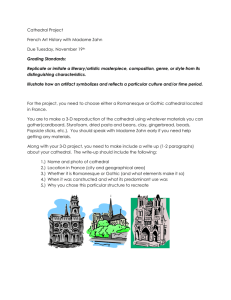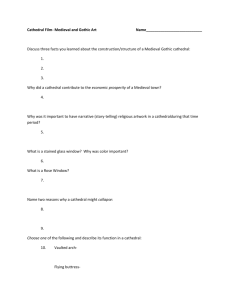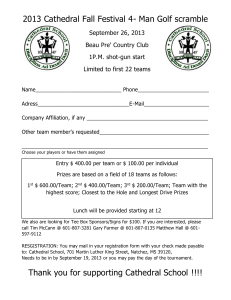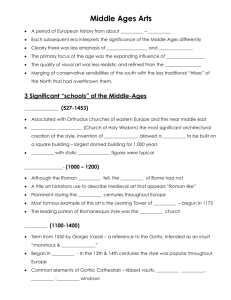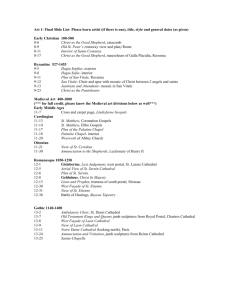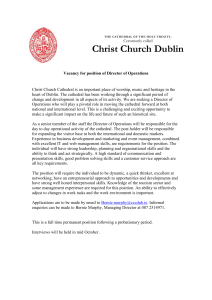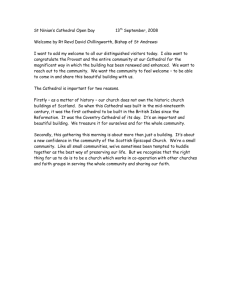Study Guide 12 GOTHIC
advertisement
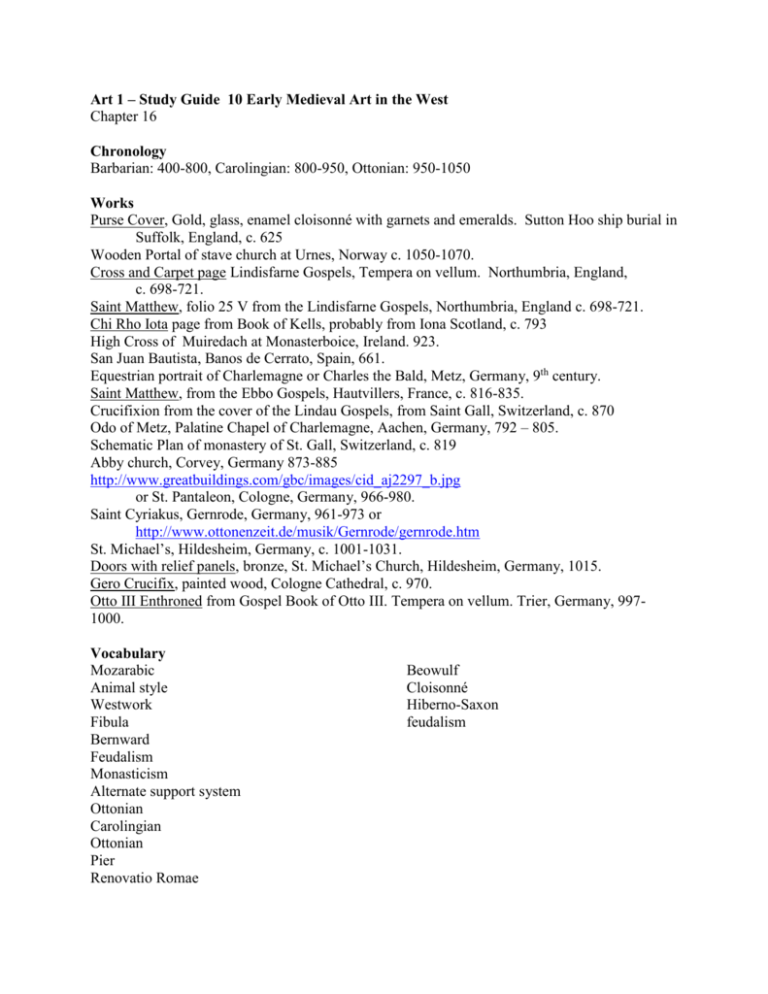
Art 1 – Study Guide 10 Early Medieval Art in the West Chapter 16 Chronology Barbarian: 400-800, Carolingian: 800-950, Ottonian: 950-1050 Works Purse Cover, Gold, glass, enamel cloisonné with garnets and emeralds. Sutton Hoo ship burial in Suffolk, England, c. 625 Wooden Portal of stave church at Urnes, Norway c. 1050-1070. Cross and Carpet page Lindisfarne Gospels, Tempera on vellum. Northumbria, England, c. 698-721. Saint Matthew, folio 25 V from the Lindisfarne Gospels, Northumbria, England c. 698-721. Chi Rho Iota page from Book of Kells, probably from Iona Scotland, c. 793 High Cross of Muiredach at Monasterboice, Ireland. 923. San Juan Bautista, Banos de Cerrato, Spain, 661. Equestrian portrait of Charlemagne or Charles the Bald, Metz, Germany, 9th century. Saint Matthew, from the Ebbo Gospels, Hautvillers, France, c. 816-835. Crucifixion from the cover of the Lindau Gospels, from Saint Gall, Switzerland, c. 870 Odo of Metz, Palatine Chapel of Charlemagne, Aachen, Germany, 792 – 805. Schematic Plan of monastery of St. Gall, Switzerland, c. 819 Abby church, Corvey, Germany 873-885 http://www.greatbuildings.com/gbc/images/cid_aj2297_b.jpg or St. Pantaleon, Cologne, Germany, 966-980. Saint Cyriakus, Gernrode, Germany, 961-973 or http://www.ottonenzeit.de/musik/Gernrode/gernrode.htm St. Michael’s, Hildesheim, Germany, c. 1001-1031. Doors with relief panels, bronze, St. Michael’s Church, Hildesheim, Germany, 1015. Gero Crucifix, painted wood, Cologne Cathedral, c. 970. Otto III Enthroned from Gospel Book of Otto III. Tempera on vellum. Trier, Germany, 9971000. Vocabulary Mozarabic Animal style Westwork Fibula Bernward Feudalism Monasticism Alternate support system Ottonian Carolingian Ottonian Pier Renovatio Romae Beowulf Cloisonné Hiberno-Saxon feudalism Early Medieval Europe Study Questions 1. Describe the similarities and differences between San Vitale in Ravenna and the Palace Chapel at Aachen. What is the reason for the similarities? What are the dates? 2. What were the effects on art of the conversion of the Germanic tribes to Christianity? Supply specific examples with dates. 3. How would you summarize the role of Charlemagne in Northern Europe, referring specifically to his cultural and artistic efforts; what were the lasting results? Give two examples and dates. 4. The most important patrons of art during the Early Medieval period were the nobility and the clergy. Why was this? Select at least two examples of each category to describe them and discuss their styles. Include the dates! 5. Explain the significance for the subsequent development of Northern European church architecture the plan of St. Gall and the church of St. Michael at Hildesheim. Compare them and give their dates. Study Guide #11 Romanesque Chapter 17 Works St. Sernin in Toulouse, France 1070-1120 Bernardus Gelduinus, Christ in Majesty, ambulatory relief in St. Sernin, ca. 1096 Speyer Cathedral in Speyer, Germany 1030-1106. St. Ambrogio in Milan, Italy late 11th – early 12th c. Pisa Cathedral, Pisa, Italy begun 1063 Saint-Etienne, Caen, France, begun 1067 Cluny III, Cluny, France, 1088-1130 Durham Cathedral, Durham, England, begun ca. 1093 The Romanesque church portal: Tympanum, archivolts, voussoirs, jambs, trumeau, lintel Wiligelmo Creation and Temptation of Adam and Eve. Modena Cathedral, c. 1110. marble Gislebertus Last Judgement, Cathedral of St. Lazare west tympanum, Autun, France, 1120-1135 Pentecost and Mission of the Apostles, La Madelaine, Vezelay, France, 1120-1132. The Second Coming (Christ in Majesty), Saint-Pierre, Moissac, France, ca. 1115-1135 Cistercian abbey church of Notre-Dame, Fontenay, France, 1139-1147 Madonna and Child, Auvergne, France wood, c. 1150 Reliquary of St. Alexander, Stavelot Abbey, Belgium. Silver, gilt bronze, gems, enamel, 17” H. dated 1145 Christ in Majesty, apse fresco from Santa Maria del Mur, Spain c. 1150 ,22 x 24’ Eadwine the Scribe at Work from the Eadwine Psalter, England. ink and tempera on vellum ca. 1160-1170 Bayeux Tapestry. Bayeux Cathedral, France c. 1070-1080. 20” x 230’ Vision of Hildegard of Bingen facsimile of lost folio from Scivias (Know the Way). Completed c. 1151 Vocabulary Trumeaux Tympanum Choir William the Conqueror Gislebertus Bayeux Tapestries Mandorla Flying buttress Tribune Radiating chapel Six partite vaulting Crusades Cistercian Archivolt Ambulatory Bernard of Clairvaux (1090-1153) Romanesque Study Questions 1. Compare the roofing of the nave and aisles in St. Michael’s at Hildesheim, St. Sernin at Toulouse, and Durham Cathedral. 2. What are the symbols of the four evangelists? Give a specific dated example of their occurrence in art. 3. What effect did the Norman Conquest have on the art of England? Explain and give a specific dated example. 4.Why were ambulatories popular in pilgrimage churches? Explain and give a specific dated example. 5. What is meant by a groin vault? How does it differ from a ribbed vault? Give specific dated examples of each. 6. What is meant by the Last Judgement in Christian iconography? Why was it so popular during the Romanesque period, particularly in France? 7. How do the topics of religious art mirror the specific historical and social situations of the Church during both the Early and High Middle Ages? Discuss using well-described dated examples from sculpture, painting and mosaics. 8. Describe the major differences between and Early Christian basilica (St. Peter’s) and a Romanesque church (St. Sernin.) What are the most important ideas or motivations behind the changes? Be specific and give dates. Study Guide 12 GOTHIC Chapter 18 Chronology: Early Gothic 1145-1200 High Gothic 1200-1300 Late Gothic 1300-1500 Regional styles: France, England, Holy Roman Empire Works Abbey church, Saint-Denis, Ambulatory and radiating chapels. France, 1140-1144 Royal Portals, Chartres Cathedral, west facade 1140-50 Exterior, Notre Dame de Paris 1163 Rose Window, Chartres Cathedral 1220 Old testament kings and queen, jamb statues, central doorway, Royal Portal, Chartres, 11451155 (naturalism, three dimensional volumes attached to columns) Laon Cathedral, begun c. 1190. Pointed arches resting on ribbed vaults, triforium Saints Martin, Jerome and Gregory, Porch of the Confessors, Chartres Cathedral c. 1220 Robert de Luzarches, Thomas de Cormont, Renaud de Cormont, Amiens Cathedral, begun 1220 Visitation, Rheims Cathedral, ca. 1230 Sainte-Chapelle, Paris, 1243-1248 Virgin of Paris, Notre Dame, Paris 1320s House of Jacques Coeur, Bourges, France. 1395-1456 God as the Architect of the World, ink, tempera, gold leaf, on vellum. Paris, ca. 1220-1230 Jean Pucelle, David before Saul, Belleville Breviary, ca. 1325. Ink and tempera on vellum. The Castle of Love and Knights Jousting, ivory and iron lid of jewelry box 4 ½ x 9 ¾ “ Salisbury Cathedral, Salisbury, England 1220-1258 decorated style Tomb of Edward II, Gloucester Cathedral, England ca. 1330-1335 Cologne Cathedral begun 1248 Church of Saint Elizabeth, Marburg, Germany 1235-1283, hall church Ekkehard and Uta, Naumburg Cathedral, painted limestone ca. 1249-1255 Bamberg Rider, c. 1235-1240 sandstone. Bamberg Cathedral, Germany Röttgen Pieta, c. 1300-1325. Rhineland, Germany, painted wood. Nicholas of Verdun, Shrine of the Three Kings, ca. 1190, Cologne Cathedral, Germany Vocabulary Archivolt Elegant style Flamboyant Gothic Mariology Perpendicular Gothic Triforium Abbot Sugar Hall Church Ile de France Rayonnant style Theme of Chivalrous Knight and His Lady in the Castle Fan vaults Use textbook vocabulary for the Gothic Cathedral Gothic Study Questions 1. What is generally believed to have been the purpose of the sculptural programs of the portals of the great Gothic cathedrals? How did these programs differ from the sculptural programs of the Romanesque portals? 2. Assess the role of light in Gothic architecture from the point of view both of symbolism and structure. 3. How did the “poetry of love” or romance literature, influence the luxury arts? Support your essay with specific examples. 4.Contrast Chartres Cathedral and Salisbury Cathedral. How does each reflect its regional style? Which elements are similar and which are different and why?

